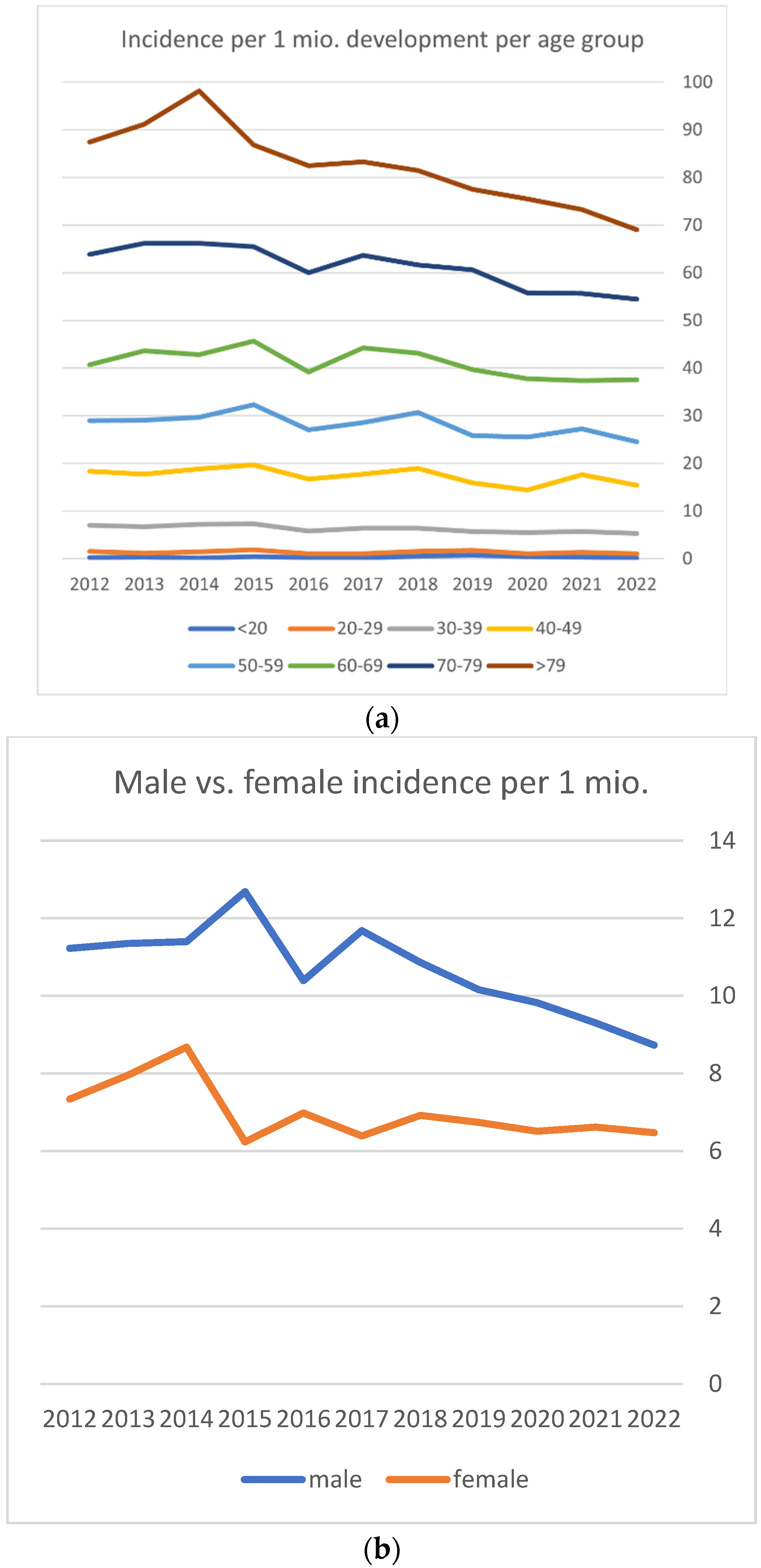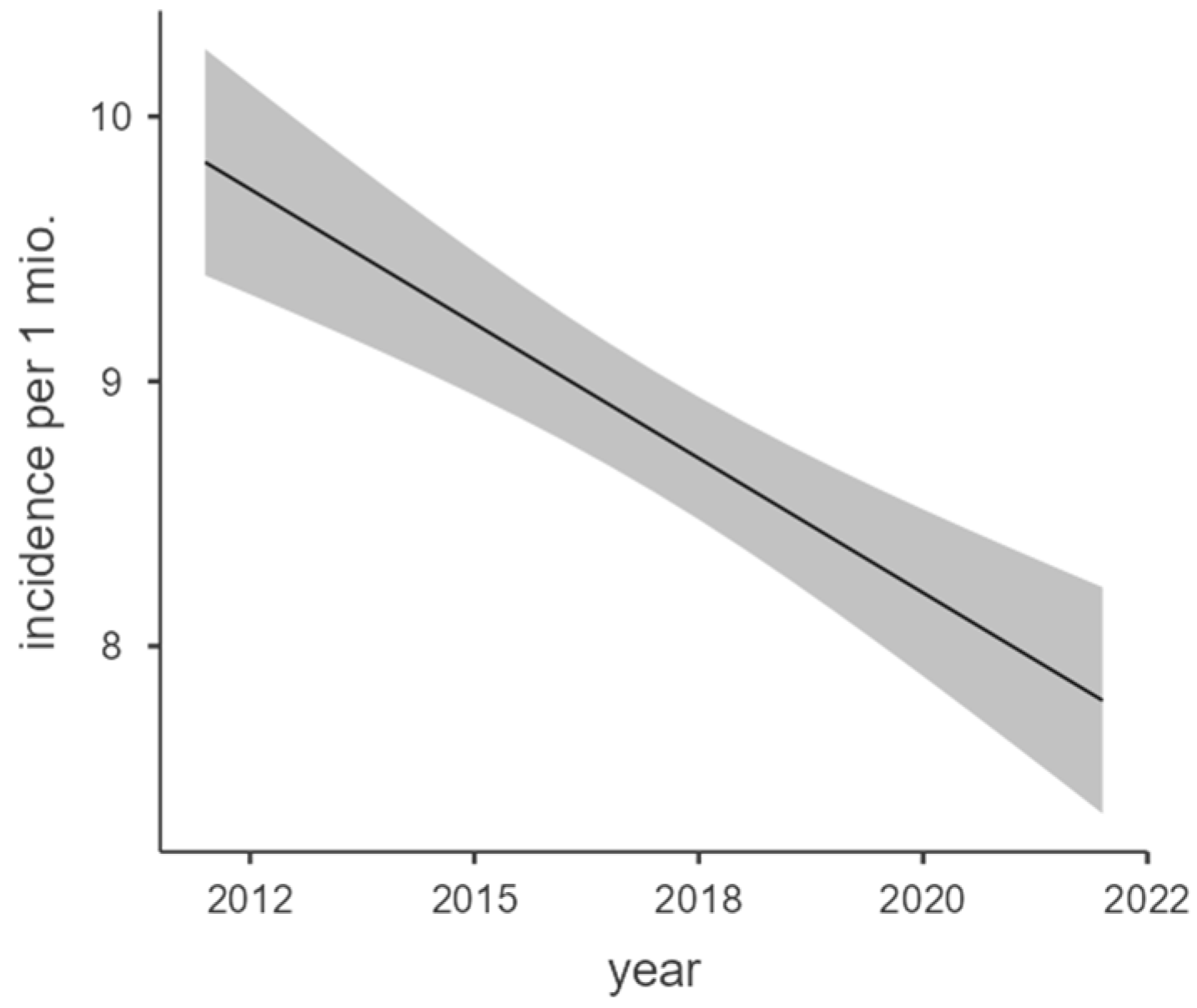Incidence and Epidemiology of Kidney Infarctions in Germany—A Cohort Study
Abstract
1. Introduction
2. Materials and Methods
2.1. Data Collection
2.2. Statistical Analysis
3. Results
4. Discussion
Limitations
5. Conclusions
Author Contributions
Funding
Institutional Review Board Statement
Informed Consent Statement
Data Availability Statement
Conflicts of Interest
References
- Lessman, R.K.; Johnson, S.F.; Coburn, J.W.; Kaufman, J.J. Renal artery embolism: Clinical features and long-term follow-up of 17 cases. Ann. Intern. Med. 1978, 89, 477–482. [Google Scholar] [CrossRef] [PubMed]
- Mulayamkuzhiyil Saju, J.; Leslie, S.W. Renal Infarction. In StatPearls; StatPearls Publishing: Treasure Island, FL, USA, 2024. Available online: http://www.ncbi.nlm.nih.gov/books/NBK582139/ (accessed on 3 March 2024).
- Bourgault, M.; Grimbert, P.; Verret, C.; Pourrat, J.; Herody, M.; Halimi, J.M.; Karras, A.; Amoura, Z.; Jourde-Chiche, N.; Izzedine, H.; et al. Acute renal infarction: A case series. Clin. J. Am. Soc. Nephrol. 2013, 8, 392–398. [Google Scholar] [CrossRef] [PubMed]
- Scolari, F.; Ravani, P.; Gaggi, R.; Santostefano, M.; Rollino, C.; Stabellini, N.; Colla, L.; Viola, B.F.; Maiorca, P.; Venturelli, C.; et al. The Challenge of Diagnosing Atheroembolic Renal Disease: Clinical features and prognostic factors. Circulation 2007, 116, 298–304. [Google Scholar] [CrossRef] [PubMed]
- Alshehri, A.M. Stroke in atrial fibrillation: Review of risk stratification and preventive therapy. J. Fam. Community Med. 2019, 26, 92–97. [Google Scholar] [CrossRef] [PubMed]
- Yousuf, T.; Ziffra, J.; Iqbal, H.; Said, A.; Oyama, J.H.; Lerma, E.V.; Chadaga, A.R. Two Cases of Acute Renal Infarction in the Setting of Atrial Fibrillation. Ochsner J. 2016, 16, 312–314. [Google Scholar] [PubMed]
- Cheng, L.; Wu, Y. Mesenteric Ischemia and Myocardial Infarction Associated with Atrial Fibrillation. Case Rep. Cardiol. 2018, 2018, 7860397. [Google Scholar] [CrossRef] [PubMed]
- Paris, B.; Bobrie, G.; Rossignol, P.; Le Coz, S.; Chedid, A.; Plouin, P.-F. Blood pressure and renal outcomes in patients with kidney infarction and hypertension. J. Hypertens. 2006, 24, 1649. [Google Scholar] [CrossRef] [PubMed]
- Scolari, F.; Bracchi, M.; Valzorio, B.; Movilli, E.; Costantino, E.; Savoldi, S.; Zorat, S.; Bonardelli, S.; Tardanico, R.; Maiorca, R. Cholesterol atheromatous embolism: An increasingly recognized cause of acute renal failure. Nephrol. Dial. Transplant. 1996, 11, 1607–1612. [Google Scholar] [CrossRef] [PubMed]
- Mesiano, P.; Rollino, C.; Beltrame, G.; Ferro, M.; Quattrocchio, G.; Fenoglio, R.; Pozzato, M.; Cecere, P.; Forneris, G.; Bazzan, M.; et al. Acute renal infarction: A single center experience. J. Nephrol. 2017, 30, 103–107. [Google Scholar] [CrossRef] [PubMed]
- Traube, L. Über den Zusammenhang von Herz- und Nieren-Krankheiten; A. Hirschwald: Berlin, Germany, 1856; p. 77. [Google Scholar]
- Domanovits, H.; Paulis, M.; Nikfardjam, M.; Meron, G.; Kürkciyan, I.; Bankier, A.A.; Laggner, A.N. Acute renal infarction. Clinical characteristics of 17 patients. Medicine 1999, 78, 386–394. [Google Scholar] [CrossRef] [PubMed]
- Ayach, T.; Kazory, A. Bilateral renal infarction: An uncommon presentation of fibromuscular dysplasia. Clin. Kidney J. 2013, 6, 646–649. [Google Scholar] [CrossRef] [PubMed]
- GBE—Gesundheitsberichterstattung des Bundes. Available online: https://www.gbe-bund.de/gbe/ (accessed on 3 March 2024).
- BfArM—ICD-10-GM Version 2024. Available online: https://klassifikationen.bfarm.de/icd-10-gm/kode-suche/htmlgm2024/index.htm (accessed on 3 March 2024).
- Statistisches Bundesamt Deutschland—GENESIS-Online. 3 March 2024. Available online: https://www-genesis.destatis.de/genesis/online#astructure (accessed on 3 March 2024).
- Kim, D.-E.; Moon, I.; Park, S.; Park, M.; Park, S.; Kwon, S.S.; Kong, M.G.; Park, H.W.; Choi, H.O.; Seo, H.-S.; et al. Temporal Trend of the Incidence and Characteristics of Renal Infarction: Korean Nationwide Population Study. J. Korean Med. Sci. 2023, 38, e239. [Google Scholar] [CrossRef] [PubMed]
- Hoxie, H.J.; Coggin, C.B. Renal Infarction: Statistical Study of Two Hundred and Five Cases and Detailed Report of an Unusual Case. Arch. Intern. Med. 1940, 65, 587–594. [Google Scholar] [CrossRef]
- Huang, C.-C.; Lo, H.-C.; Huang, H.-H.; Kao, W.-F.; Yen, D.H.-T.; Wang, L.-M.; Huang, C.-I.; Lee, C.-H. ED presentations of acute renal infarction. Am. J. Emerg. Med. 2007, 25, 164–169. [Google Scholar] [CrossRef] [PubMed]
- Korzets, Z.; Plotkin, E.; Bernheim, J.; Zissin, R. The clinical spectrum of acute renal infarction. Isr. Med. Assoc. J. 2002, 4, 781–784. [Google Scholar] [PubMed]
- Yang, J.; Lee, J.Y.; Na, Y.J.; Lim, S.Y.; Kim, M.-G.; Jo, S.-K.; Cho, W. Risk factors and outcomes of acute renal infarction. Kidney Res. Clin. Pract. 2016, 35, 90–95. [Google Scholar] [CrossRef] [PubMed]
- Voss, A.; Kollhorst, B.; Platzbecker, K.; Amann, U.; Haug, U. Risk Profiles of New Users of Oral Anticoagulants Between 2011 and 2019 in Germany. Clin. Epidemiol. 2023, 15, 827–837. [Google Scholar] [CrossRef] [PubMed]
- Global Cardiovascular Risk Consortium; Magnussen, C.; Ojeda, F.M.; Leong, D.P.; Alegre-Diaz, J.; Amouyel, P.; Aviles-Santa, L.; De Bacquer, D.; Ballantyne, C.M.; Bernabé-Ortiz, A.; et al. Global Effect of Modifiable Risk Factors on Cardiovascular Disease and Mortality. N. Engl. J. Med. 2023, 389, 1273–1285. [Google Scholar] [CrossRef] [PubMed]
- Giner-Soriano, M.; Prat-Vallverdú, O.; Ouchi, D.; Vilaplana-Carnerero, C.; Morros, R. Sex and gender differences in the use of oral anticoagulants for non-valvular atrial fibrillation: A population-based cohort study in primary health care in catalonia. Front. Pharmacol. 2023, 14, 1110036. [Google Scholar] [CrossRef] [PubMed]
- Raccah, B.H.; Perlman, A.; Zwas, D.R.; Hochberg-Klein, S.; Masarwa, R.; Muszkat, M.; Matok, I. Gender Differences in Efficacy and Safety of Direct Oral Anticoagulants in Atrial Fibrillation: Systematic Review and Network Meta-analysis. Ann. Pharmacother. 2018, 52, 1135–1142. [Google Scholar] [CrossRef] [PubMed]
- Matrisch, L.; Karsten, H.; Schücke, J.; Rau, Y. Increase in Registered Acute Kidney Injuries in German Hospitals. Cureus 2023, 15, e36868. [Google Scholar] [CrossRef] [PubMed]



| Mean | Standard Deviation | Minimum | Maximum | |
|---|---|---|---|---|
| overall | 8.81 | 0.745 | 7.59 | 10 |
| female | 6.99 | 0.745 | 6.24 | 8.68 |
| male | 10.7 | 1.14 | 8.73 | 12.7 |
| age groups | ||||
| <20 | 0.329 | 0.191 | 0.126 | 0.718 |
| 20–29 | 1.04 | 0.259 | 0.616 | 1.5 |
| 30–39 | 4.93 | 0.62 | 3.99 | 5.8 |
| 40–49 | 11.1 | 1.06 | 8.94 | 12.6 |
| 50–59 | 10.7 | 0.993 | 9.14 | 12.7 |
| 60–69 | 12.9 | 1.49 | 10.1 | 15.7 |
| 70–79 | 20.2 | 2.21 | 16.9 | 23.4 |
| >80 | 21.1 | 4.67 | 14.6 | 31.9 |
| Age Group | p | Effect Size d |
|---|---|---|
| <20 | 0.745 | 0.141 |
| 20–29 | 0.413 | −0.356 |
| 30–39 | <0.001 | 4.539 |
| 40–49 | <0.001 | 6.719 |
| 50–59 | <0.001 | 6.356 |
| 60–69 | <0.001 | 2.697 |
| 70–79 | 0.02 | 1.080 |
| >79 | 0.189 | −0.58 |
| Study | Country | Methods | Number of Patients | Patient Collective | Incidence |
|---|---|---|---|---|---|
| Kim et al., 2023 [17] | South Korea | Claims data | 51,849,591 | General population | 2.68 to 3.06 per 100,000 person-years |
| Huang et al., 2007 [19] | Taiwan | Computer tomography | 481,540 | Emergency department | 0.004% of patients |
| Korzets et al., 2002 [20] | Israel | Computer tomography | 151,914 | Hospitalized patients | 0.007% of patients |
| Hoxie et al., 1940 [18] | USA | Autopsy | 14,411 | Deceased patients | 1.4% of patients |
| Paris et al., 2006 [8] | France | intraarterial subtraction angiography | 18,287 | Patients referred to hypertension unit | 0.018% per year |
| Domanovits et al., 1999 [12] | Austria | Computer tomography | 248,842 | Emergency department | 0.007% of patients |
Disclaimer/Publisher’s Note: The statements, opinions and data contained in all publications are solely those of the individual author(s) and contributor(s) and not of MDPI and/or the editor(s). MDPI and/or the editor(s) disclaim responsibility for any injury to people or property resulting from any ideas, methods, instructions or products referred to in the content. |
© 2025 by the authors. Licensee MDPI, Basel, Switzerland. This article is an open access article distributed under the terms and conditions of the Creative Commons Attribution (CC BY) license (https://creativecommons.org/licenses/by/4.0/).
Share and Cite
Rau, Y.; Matrisch, L. Incidence and Epidemiology of Kidney Infarctions in Germany—A Cohort Study. Epidemiologia 2025, 6, 19. https://doi.org/10.3390/epidemiologia6020019
Rau Y, Matrisch L. Incidence and Epidemiology of Kidney Infarctions in Germany—A Cohort Study. Epidemiologia. 2025; 6(2):19. https://doi.org/10.3390/epidemiologia6020019
Chicago/Turabian StyleRau, Yannick, and Ludwig Matrisch. 2025. "Incidence and Epidemiology of Kidney Infarctions in Germany—A Cohort Study" Epidemiologia 6, no. 2: 19. https://doi.org/10.3390/epidemiologia6020019
APA StyleRau, Y., & Matrisch, L. (2025). Incidence and Epidemiology of Kidney Infarctions in Germany—A Cohort Study. Epidemiologia, 6(2), 19. https://doi.org/10.3390/epidemiologia6020019






